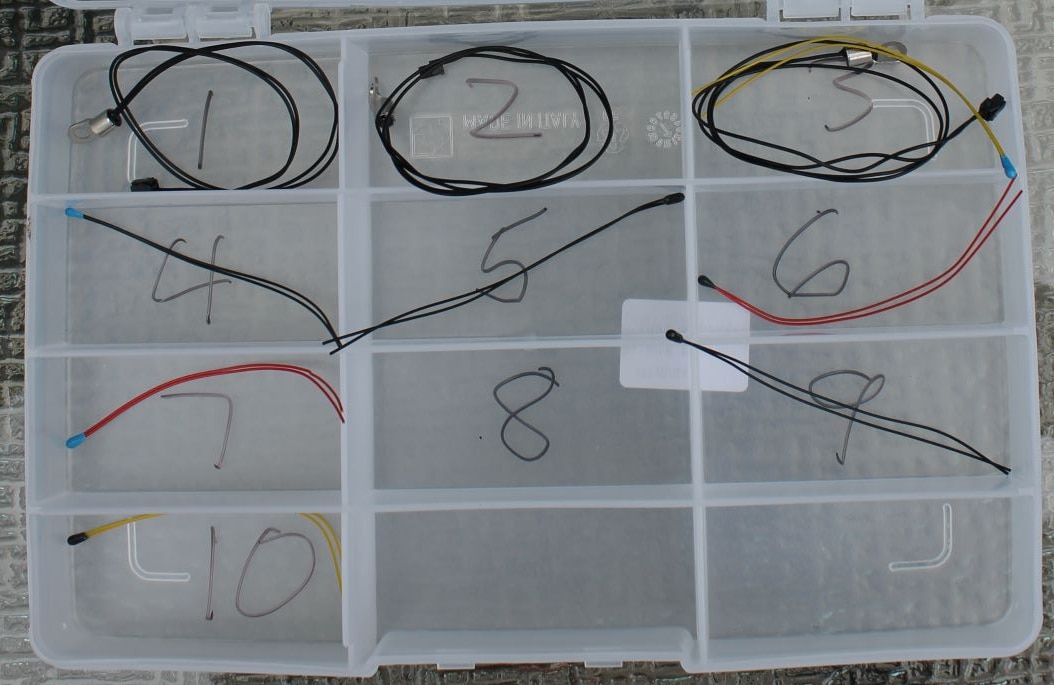As soon as I saw the announcement for the ‘Experimenting with Thermistors’ challenge, I knew I would be thrilled to have my name on challenger list. Thank you to Element14 and Molex for selecting as one of 10 experimenters to receive an assortment of Molex thermistors to experiment with. The kit arrived safe and sound and neatly organized on July 15, thanks to great staff at element14!

The 7 bead style Molex thermistors I received as part of the experimenters kit are as follows:
| R25 | Beta | Wire Color | Epoxy Color | Datasheet |
| 3k | 3892K | black | black | https://www.molex.com/molex/products/part-detail/cable_assemblies/2152723307 |
| 4k7 | 3892K | black | blue | https://www.molex.com/molex/products/part-detail/cable_assemblies/2152723407 |
| 5k | 3892K | red | black | https://www.molex.com/molex/products/part-detail/cable_assemblies/2152723507 |
| 10k | 3892K | black | black | https://www.molex.com/molex/products/part-detail/cable_assemblies/2152723607 |
| 12k | 3892K | red | blue | https://www.molex.com/molex/products/part-detail/cable_assemblies/2152723707 |
| 30k | 3892K | yellow | blue | https://www.molex.com/molex/products/part-detail/cable_assemblies/2152723807 |
| 47k | 3892K | yellow | black | https://www.molex.com/molex/products/part-detail/cable_assemblies/2152723907 |
The 3 ring-terminal mount Molex thermistors are:
| R25 | Beta | Datasheet |
| 10k | 3500k | https://www.molex.com/molex/products/part-detail/cable_assemblies/2138601637 |
| 10k | 3500k | https://www.molex.com/molex/products/part-detail/cable_assemblies/2138602637 |
| 10k | 3800k | https://www.molex.com/molex/products/part-detail/cable_assemblies/2138622637 |
Before you get too excited about the induvial unit prices, it is important to remember that these are not just bare thermistors. Rather, the Molex products are temperature measurement probes/sub-assemblies, with 1% tolerances on R25 and beta. They only have 2 leads and being thermal-resistors they are inherently electrically un-polarized. They aren’t ESD sensitive, within reason I suppose. Even better yet, they are extremely sensitive to temperature changes, the specific value vary per thermistor and over temperature, but typical figures are anywhere from -2%/degC to -5% /degC. The list could go own, suffice it to say they are more than just bare thermistors.
Who is Scottie?
At times she is an electronics designer and at other times she is a professional tinkerbell. She has been an electronics hobbyist the vast majority of her life and collected a number of technical hats along the way (and cute shoes) along the way. My contributions on element14 have been rooted in sharing my love, passion, and knowledge of electronics design with the other 700k+ extraordinary individuals who make up the element14 community.
The Experiment
For this “experimenting with” competition I have chosen a well defined thermistor problem that I am interested in experimenting with. Sampling one thermistor is great, but perhaps you would like to sample 2, 3, or even 16 thermistors while only having a single Analog to Digital Converter (ADC).

The are few different circuit topologies I can think of, each with their own pros and cons. As a result of my experiments I hope to shed some light on this topic and learn lots about thermistors along the way! (I already am :))
Golden Samples for the Golden Girl
I don’t have the personal means to create any of the cardinal temperature points on the ITS-90 temperature scale. So, if I were to make any experimental temperature measurements they would all referenced against a temperature measurement probe. Given the resources available to me, my measurement uncertainty budget would be at least 1 to 2 orders of magnitude off what a fully funded R&D lab could achieve. So, I don’t intend to focus on experimentally determining the exact relation between the operating temperature and electrical resistance of an NTC thermistor. From the circuit designers perspective, it is the thermistor supplier’s role to describe and document what the temperature-resistance function is. We only need to recognize that the relation is Highly non-linear and that thermistor’s resistance may vary by 2 orders of magnitude over a 100 degC temperature span.
As such, I have constructed 6 golden resistance samples that model the equivalent resistance of a 10 kOhm thermistor at temperatures varying from -25 degC to +100 degC. In the mechanical drawing for 10 kOhm thermistor (215272-3607), there is a temperature-resistance table. From this resistance table, I noted the nominal resistance at 6 temperature as shown my golden sample table below. I tried my best to select/construct an equivalent resistance from the metal film resistors I had on hand.

I measured the resistance of the samples in 4-wire mode with my 6-1/2 digit multi-meter (HP 34401A).
I will acknowledge that these samples may be slightly tarnished, in that they won’t model the self-heating effects of a real thermistor that arises from the I2R power due to the measurement excitation current.
Defining Experimental Success
In this element14 event, I only intended to author two formal blogs. The first blog is this introductory blog and the second blog will present and summarize my experiments, achievements, and learnings over the course of the 2 month challenge period. Additionally, I consider my forum posts to be my personal experimental logbook of my measurements and learnings. At the time of authoring this post, I have thus far spent considerable time learning/refreshing my memory on the theory, operation, models, and simulation of thermistors.
As far as I am concerned, If I am able complete the two required blogs for this challenge while spreading good cheer and perhaps a few technical insights into thermistors, I will consider my experiment to be a great success!
Now as the big element14 sharks circle the prize pool, (I’m told technical sharks have an supper sense of smell for coffee), this little starfish will tinker away on her experiments!
Thanks for reading and take care.

Top Comments